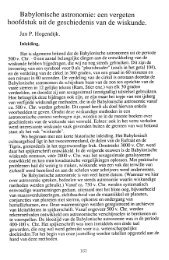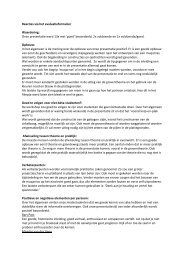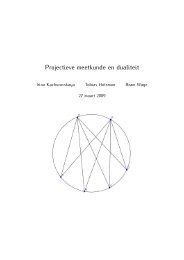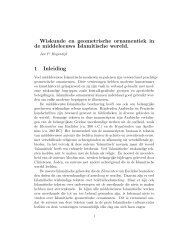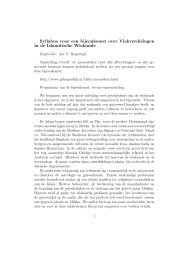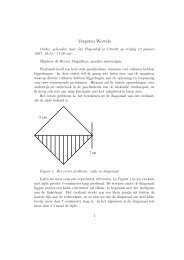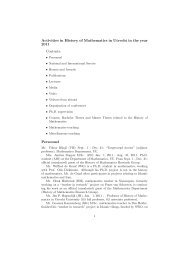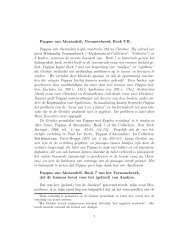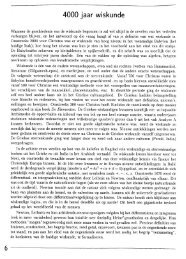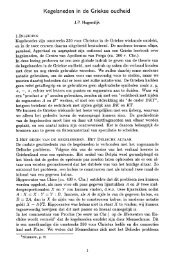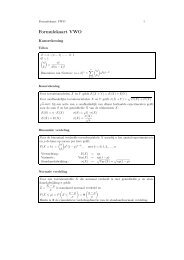Desargues' Brouillon Project and the Conics of ... - J.P. Hogendijk
Desargues' Brouillon Project and the Conics of ... - J.P. Hogendijk
Desargues' Brouillon Project and the Conics of ... - J.P. Hogendijk
You also want an ePaper? Increase the reach of your titles
YUMPU automatically turns print PDFs into web optimized ePapers that Google loves.
38 Jan I? <strong>Hogendijk</strong><br />
[<strong>the</strong>n] The vertex <strong>of</strong> this cone is given in position, <strong>and</strong> <strong>the</strong> cone is given in kind<br />
<strong>and</strong> position, <strong>the</strong> figure <strong>of</strong> <strong>the</strong> section given by <strong>the</strong> position <strong>of</strong> <strong>the</strong> cutting plane is<br />
given in kind <strong>and</strong> position, .... <strong>the</strong> butt <strong>of</strong> <strong>the</strong> ordinance <strong>of</strong> its diametrals (i.e. <strong>the</strong> centre)<br />
<strong>and</strong> <strong>the</strong> focal points, each <strong>of</strong> <strong>the</strong>se is given in its derivation, kind <strong>and</strong> position.<br />
[3] That if <strong>the</strong> vertex, <strong>the</strong> basis, <strong>the</strong> transversal <strong>and</strong> <strong>the</strong> cutting plane are given in<br />
position, all <strong>the</strong> rest is similarly given in its derivation, kind <strong>and</strong> position.<br />
These conclusions call for some comments.26 In [l], Desargues<br />
refers to <strong>the</strong> cone with base <strong>the</strong> conic section r<strong>and</strong> apex point 8 as<br />
in Figure 19. As we have seen, this cone intersects a plane parallel<br />
to <strong>the</strong> plane BAD in a conic f’ with foci X‘ <strong>and</strong> Q‘. We note that<br />
Desargues’ pro<strong>of</strong> is only correct in <strong>the</strong> case where f’ is an ellipse.<br />
Iff ’ is a parabola, point F must lie on f <strong>and</strong> it must coincide with<br />
one <strong>of</strong> <strong>the</strong> points X <strong>and</strong> Q, say X; <strong>the</strong> o<strong>the</strong>r point Q must be on<br />
line HF (for <strong>the</strong> projection <strong>of</strong> HF is <strong>the</strong> axis <strong>of</strong> <strong>the</strong> parabola). Clearly,<br />
Desargues had not yet studied this case in detail. If line 1 meets r<br />
at two points, r‘ is a hyperbola. If X <strong>and</strong> Q are to be projected on<br />
<strong>the</strong> foci <strong>of</strong> f’, <strong>the</strong>y must lie “on <strong>the</strong> concave side” <strong>of</strong> r, i.e. inside<br />
<strong>the</strong> cone with apex 8 <strong>and</strong> base f. Now point F is outside <strong>the</strong> cone,<br />
so A must be inside <strong>the</strong> cone, <strong>and</strong> no tangent AH to rcan be drawn.<br />
In order to include <strong>the</strong> case <strong>of</strong> <strong>the</strong> hyperbola f ’, Desargues would<br />
have had to generalize his proposition. This is not difficult, but it is<br />
clear that Desargues had only <strong>the</strong> ellipse in mind when he wrote<br />
his proposition.<br />
In part [2] <strong>of</strong> <strong>the</strong> conclusion, Desargues assumes that <strong>the</strong> conic<br />
f, line I <strong>and</strong> <strong>the</strong> angle between <strong>the</strong> base plane V<strong>and</strong> <strong>the</strong> intersecting<br />
plane W are given. Note that because f <strong>and</strong> I are given, <strong>the</strong><br />
involution IT is also determined. Desargues <strong>the</strong>n makes one <strong>of</strong> <strong>the</strong><br />
five additional assumptions [2a], ..., [2e]. His assumptions are not<br />
completely ac~urate,~’ but <strong>the</strong>y amount to saying that in [2a] <strong>and</strong><br />
[2b] <strong>the</strong> involution CT is assumed, <strong>and</strong> in [2c], [2d] <strong>and</strong> [2e] <strong>the</strong><br />
involution cp is assumed (so by <strong>the</strong> proposition that he has just<br />
proved, <strong>the</strong> existence <strong>of</strong> CT is also proved). He <strong>the</strong>n correctly concludes<br />
that <strong>the</strong> apex 8 <strong>of</strong> <strong>the</strong> cone is determined, <strong>and</strong> hence also <strong>the</strong><br />
shape <strong>of</strong> <strong>the</strong> intersection f’ <strong>and</strong> (once <strong>the</strong> intersecting plane has<br />
been fixed) <strong>the</strong> centre F’. Desargues says that <strong>the</strong> foci <strong>of</strong> f’ are also<br />
given, <strong>and</strong> this is correct in <strong>the</strong> cases [2c], [2d] <strong>and</strong> [2e], where X<br />
<strong>and</strong> Q are determined. However, Desargues assumes in [2a] <strong>and</strong><br />
[2b] a converse <strong>of</strong> <strong>the</strong> proposition that he has just proved, namely




